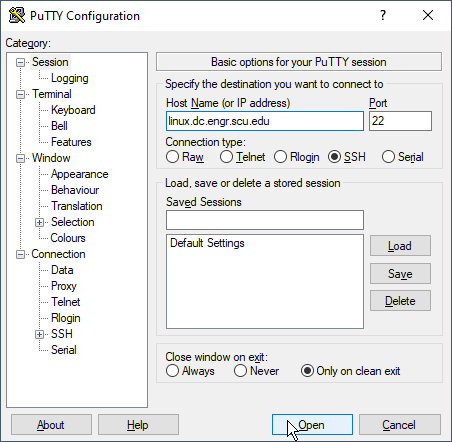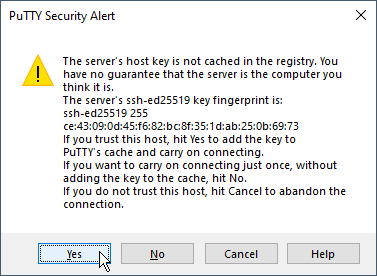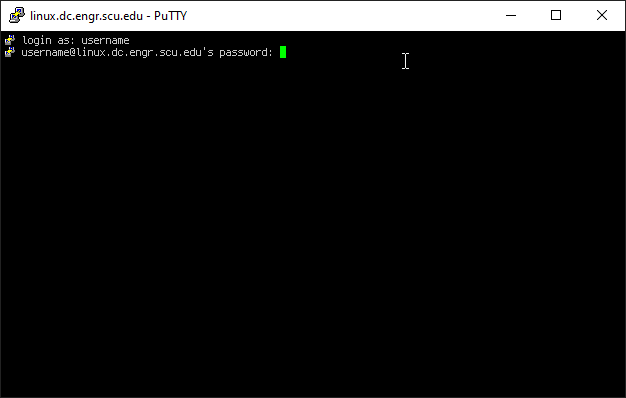SSH
SSH provides remote, text-based access to Unix systems. It is a secure replacement for Telnet, with several additional features.
Pre-requisites for remote access
- Duo: You will need to have Duo set up. If you already have Duo set up, skip to step 2. If you do not have Duo set up yet, follow the instructions in the Duo Setup Quickstart.
- VPN: Next, you will need to download and install the SCU VPN client. Connect to the VPN before you remotely access the ECC. If you do not have the VPN set up yet, follow these instructions.
- SCU Username and Password: Use your SCU Username and Password to connect to the ECC.
- OnGuard: To access the ECC from eduroam, your computer must have OnGuard installed and pass all the security checks. To install OnGuard and make sure your computer passes the security checks, follow these instructions.
Depending on the operating system used on the computer you're connecting from, you may or may not need to install an SSH client first.
- Windows 10: Built-in client. Simply use the ssh command from a PowerShell or CMD terminal. (Or download and use PuTTY as described below)
- Windows 7 and earlier: No client provided. Download the PuTTY Windows Installer Package
- macOS: Built-in client. Simply use the ssh command from a Terminal window.
- To access the terminal on macOS, open "Applications" in finder, open the "Utilities" folder, run the "Terminal" application.
- Linux: Built-in client. Simply run the ssh command from a terminal.
- Command-line ssh:
$ ssh <username>@linux.dc.engr.scu.edu <username>@linux.dc.engr.scu.edu's password: <password>
NOTE: For <username> you must enter your SCU username (SCU Gmail, without the @scu.edu portion, in all lowercase)
NOTE2: When typing your SCU password, nothing will be echoed to show you're typing, but your keypresses are being registered.
- PuTTY
- Host Name: linux.dc.engr.scu.edu
- Click "Open"
- Login as: <username>
- Password: <password>
NOTE: The first time you connect to a host, you will be asked to accept that host's key. Once you do, any future connections to the same host will verify the saved key against the key offered by the host. The point here is to protect you from someone intercepting your connection. If you ever get a warning saying that the host key has changed, do not connect. Instead, contact us and let us know what happened.
- PuTTY
Any Linux system in the Engineering Computing Center may be accessed via SSH through its fully qualified domain name. (ie, <hostname>.engr.scu.edu or <hostname>.dc.engr.scu.edu)
For your convenience, we provide an alias which will select a random ECC Linux lab workstation:
- Linux:
linux.dc.engr.scu.edu
Example Sessions
First Connection:
-
$ ssh username@linux.dc.engr.scu.edu The authenticity of host 'linux.dc.engr.scu.edu (129.210.16.71)' can't be established. ECDSA key fingerprint is SHA256:1G0/OsWK1W8FA/0ZhFOeM9Nez75YXscL7MoztYQ4AiI. ECDSA key fingerprint is MD5:25:66:8a:6d:d0:50:04:07:f3:ef:ff:73:40:61:2b:a8. Are you sure you want to continue connecting (yes/no)? yes Warning: Permanently added 'linux.dc.engr.scu.edu,129.210.16.71' (ECDSA) to the list of known hosts. username@linux.dc.engr.scu.edu's password: Last login: Thu Mar 19 13:10:34 2020 from linux10603.dc.engr.scu.edu [username@linux ~]$
Second Connection:
-
$ ssh username@linux.dc.engr.scu.edu username@linux.dc.engr.scu.edu's password: [username@linux ~]$
- Enter the hostname and click "Open"

- Initial connection dialog. Click "Yes"

- Enter your SCU username (SCU Gmail, without the @scu.edu portion) and password
